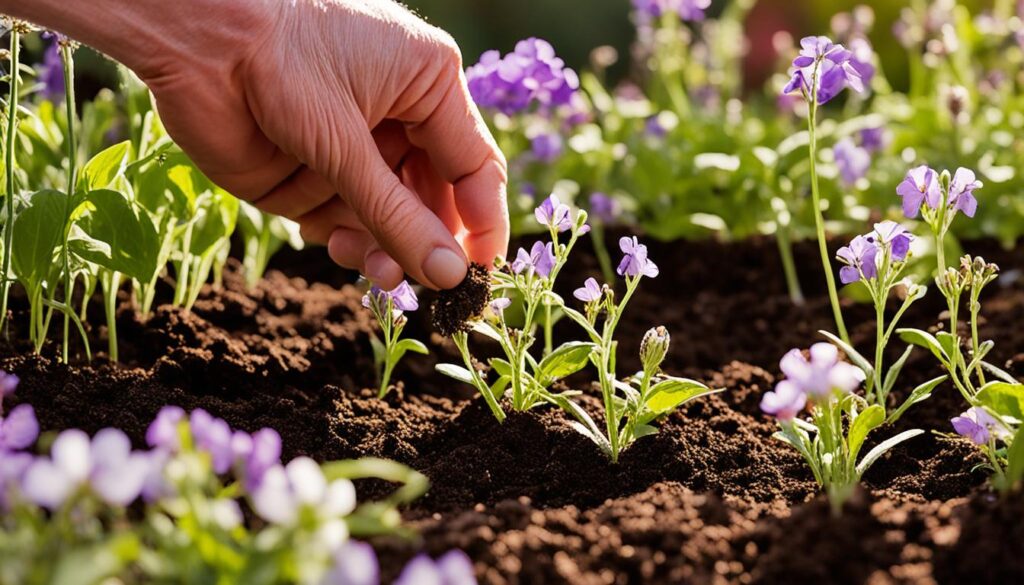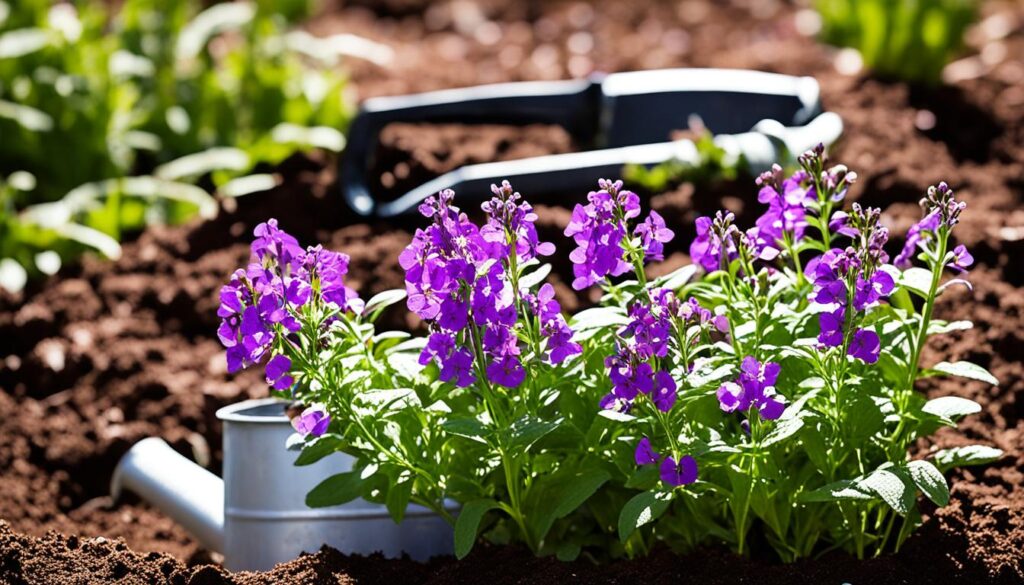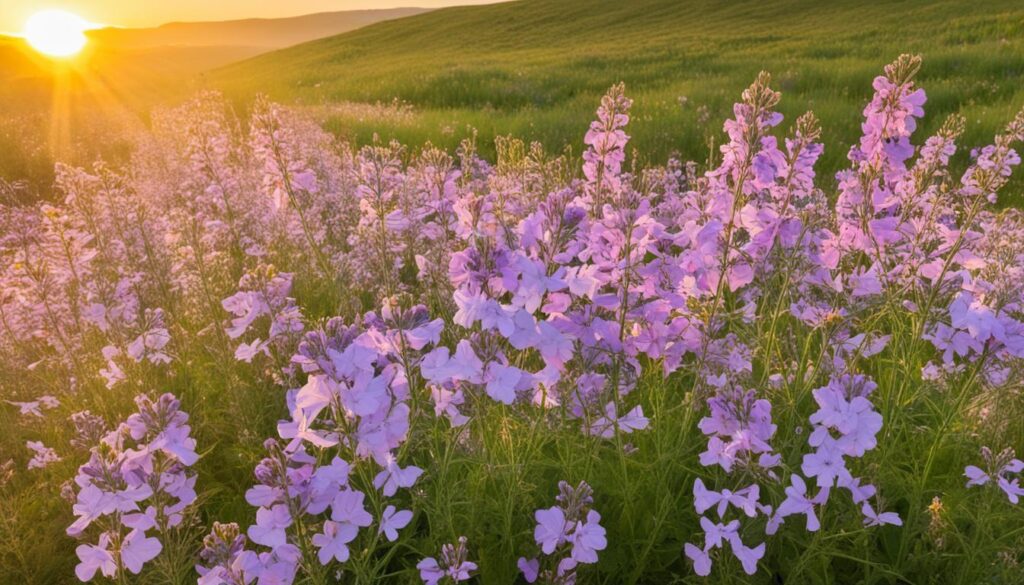Welcome to the enchanting world of Hesperis, also known as Dame’s Rocket. This plant adds beauty and a lovely scent to your garden. It also helps make your garden a home for more life.
Starting to grow Hesperis will show you its deep cultural value. You’ll learn how it can be a great addition to your garden. We’ll show you how to take care of the Hesperis plant so it does well in your garden.
If you’re new to gardening or have been doing it for years, this info will help you use Hesperis to its fullest. Get ready to make your garden a place filled with lovely smells and beauty!
Introduction to Hesperis: The Fragrant Addition to Your Garden
Do you know the hesperis flower, also called dame’s rocket? It’s a plant that grows for two years or less. It has beautiful, fragrant flowers in purple, pink, and white. These flowers grow 2 to 4 feet tall and like sunlight to some shade.
They do well in rich, well-drained soil. The flowers bloom from late spring to early summer. This makes them perfect for cottage gardens and wildflower mixes.
What is Hesperis?
The hesperis flower is known for its beauty and sweet smell. It’s also called dame’s rocket. These flowers draw in bees and butterflies and fill the air with a sweet scent.
This makes your garden more beautiful and romantic. Adding these flowers to your garden is a great idea.
Historical Significance and Cultural Impact
Hesperis has a deep history tied to Greek mythology. It’s connected to the Hesperides, who kept the golden apples safe. This adds a special touch to the plant.
Across different cultures, hesperis has symbolized beauty. It’s often seen in art and literature. Gardeners love it for its beauty and history.
If you want to make your garden even prettier, check out this guide. It teaches you how to keep honeysuckle flowers blooming all year.
Growing Hesperis: A Step-by-Step Guide

To grow Hesperis well, plan carefully. First, choose the right location for these lovely plants. They love full sun to partial shade and need shelter from strong winds.
This keeps them safe and helps them grow strong.
Choosing the Right Location
Look for spots with good drainage and enough room for the plants to spread. Hesperis can get big, so give them space. Also, choose areas with good air flow to prevent diseases.
Soil Preparation and Planting Techniques
Soil preparation is key for Hesperis. Add compost to the soil to make it rich in nutrients. This helps the soil drain well and feed the plants.
Plant Hesperis seeds in early spring or late summer. Make sure they have enough space to grow. If you’re using young plants, make sure they’re strong before moving them outside. For more tips on planting, see this guide on clay pot gardening.
Watering and Maintenance Tips
Hesperis needs regular watering but don’t overdo it. Keep the soil moist, but let it dry a bit between waterings. Too much water can harm the roots.
Mulching around the plants helps keep moisture in and stops weeds. Deadheading the flowers makes them bloom longer and keeps your garden looking great.
Care for Hesperis: Ensuring Healthy Growth

To get your Hesperis plants to bloom and stay healthy, you need to know how to care for them. This means using the right fertilizers, controlling pests, and fighting diseases. These steps are key to a beautiful garden.
Fertilization Methods
For care for Hesperis, it’s important to fertilize the right way. Use an organic fertilizer in early spring to help them grow strong. Always follow the instructions to avoid giving too much fertilizer, which can harm your plants.
By fertilizing a little, you’ll get more flowers and better leaves. This makes sure your Hesperis plants do well all season.
Pest and Disease Management
Hesperis plants are tough, but they can face problems like aphids and diseases. Check your plants often to spot any issues early. Using pest management like ladybugs can keep pests away naturally.
Also, keep your garden clean to prevent diseases. Remove any plants that are sick right away. This helps stop diseases from spreading.
Using these tips in your care for Hesperis routine will make your garden look great. For more tips on keeping hydrangeas healthy, check out this guide.
Benefits of Hesperis in Your Garden
Adding Hesperis to your garden brings many benefits. It makes your garden look better and helps the environment. This plant is not just pretty; it also helps pollinators, which is good for your garden’s health.
Attracting Pollinators and Beneficial Insects
Hesperis benefits include attracting bees and butterflies. These insects are key for pollination. They help many plants grow in your garden.
The flowers of Hesperis are a great source of nectar for them. This makes your garden more diverse and healthy. Watching Hesperis and beneficial insects together is fun.
Enhancing Garden Aesthetics with Hesperis Flowers
Hesperis also makes your garden look better. Its bright flowers add color and texture. The plant’s sweet smell makes your garden a nice place to be.
With its beautiful blooms, Hesperis is perfect for mixed beds or borders. It adds beauty and a nice feel to your garden.
Hesperis Cultivation: Varieties and Their Features

Gardeners love to explore hesperis cultivation for its unique plants. These plants add beauty and a sweet smell to gardens. Knowing about the different types helps you pick the best for your garden.
Popular Hesperis Varieties
Hesperis matronalis is a top choice for gardeners. It’s easy to grow and blooms a lot. Hesperis japonica is also popular for its sweet smell and smaller size. These types fit many garden styles well.
Unique Characteristics of Each Variety
Each type of hesperis has its own special features. Hesperis matronalis comes in many colors, brightening up your garden. Hesperis japonica is more delicate and has a soft scent. Knowing these differences helps you choose the right one for your garden.
| Hesperis Variety | Color Variety | Height | Fragrance Strength |
|---|---|---|---|
| Hesperis matronalis | Pink, White, Purple | 24-36 inches | Strong |
| Hesperis japonica | White, Light Purple | 12-24 inches | Moderate |
Choosing the right hesperis plants can make your garden look and smell great. The right type will make your garden stand out.
Companion Planting with Hesperis
Planting Hesperis with other plants makes your garden healthier and more productive. Hesperis helps keep pests away and brings in good insects when planted with lavender and other herbs. This creates a balanced garden that looks great and works well.
Adding Hesperis to your garden makes it look beautiful and helps it work better. The flowers draw in pollinators, which are key for many plants to grow. This way, planting Hesperis with other flowers makes your garden pretty and helps it thrive.
Hesperis can live well with many plants, each adding its own benefits. Consider pairing it with honeysuckle for more beauty and wildlife support. For more tips on planting Hesperis with other plants, check out this guide.



